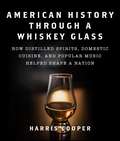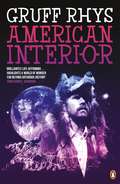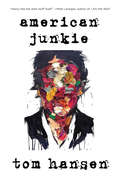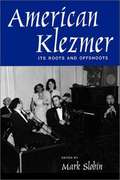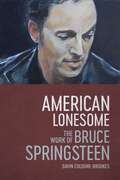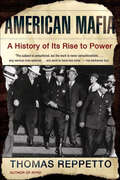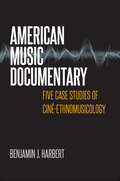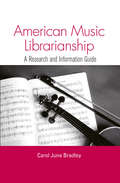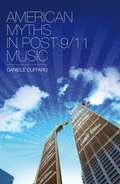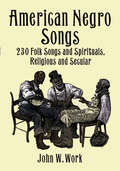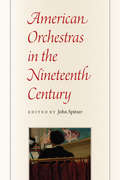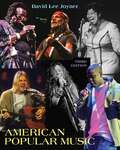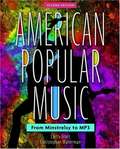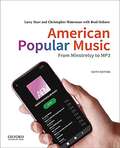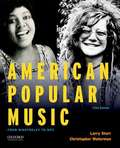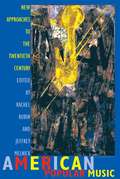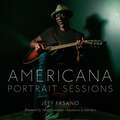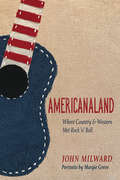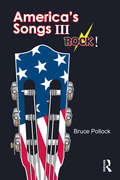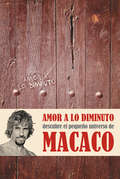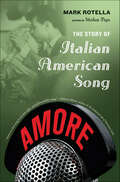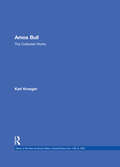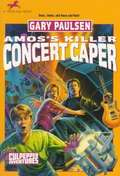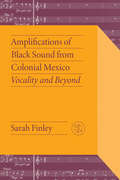- Table View
- List View
American History Through a Whiskey Glass: How Distilled Spirits, Domestic Cuisine, and Popular Music Helped Shape a Nation
by Harris CooperExperience American history like never before with this unique, informative, and fun guide for history buffs, whiskey enthusiasts, folks who like to cook at home, and fans of popular music.American History Through a Whiskey Glass presents a unique perspective on American history. It describes how bourbon and rye whiskey played a role in the most important events in American history, including the voyage of the Mayflower, George Washington&’s failed and successful political campaigns, the Civil War, pioneers moving west, Prohibition (of course), plus many more into the twenty-first century. It does so with descriptions of historical events but also with amusing anecdotes and humorous quotes from the historical figures themselves. The book carefully aligns five elements: a narrative about whiskey&’s role in eight periods of American historydescriptions and tasting notes for American whiskeys that represent distilled spirits in each historical periodtutorials on how whiskey is produced and its numerous varietiesperiod-specific food recipes drawn mostly from historical cookbooksplaylists of the popular music during each period The book gives readers an integrated and entertaining perspective on popular culture in America at different times, revealing how Americans have politicked, drank their native spirits, ate, and sang. But it does more; readers will not only learn about America&’s history, they can experience it through numerous illustrations, whiskey tasting, food, and music. It provides an opportunity for readers to be involved in a truly immersive approach to life-long learning . . . and it&’s fun.
American Interior: The Quixotic Journey of John Evans
by Gruff RhysAmerican Interior is a psychedelic historical travelogue from Welsh pop legend Gruff Rhys.In 1792, John Evans, a twenty-two-year-old farmhand from Snowdonia, Wales, travelled to America to discover whether there was indeed, as widely believed, a tribe of Welsh-speaking native Americans still walking the great plains. In 2012, Gruff Rhys set out on an 'investigative concert tour' in the footsteps of John Evans, with concerts in New Orleans, Baltimore, Philadelphia, Pittsburgh, Cincinnati, St Louis, North Dakota and more. American Interior is the story of these journeys. It is also an exploration of how wild fantasies interact with hard history and how myth-making can inspire humans to partake in crazy, vain pursuits of glory, including exploration, war and the creative arts. Gruff Rhys is known around the world for his work as a solo artist as well as singer and songwriter with Super Furry Animals and Neon Neon, and for his collaborations with Gorillaz, Dangermouse, Sparklehorse, Mogwai and Simian Mobile Disco amongst others. The latest album by Neon Neon, Praxis Makes Perfect, based on the life of radical Italian publisher Giangiacomo Feltrinelli, was recently performed as an immersive live concert with National Theatre Wales.
American Junkie
by Tom HansenA non-stop trip into one man's land of desperate addicts, failed punk bands, and brushes with sad fame, as he sells drugs during the Seattle grunge years. In American Junkie, Tom Hansen maps his heroin addiction, from the promise of a young life to the prison of a mattress, from budding musician to broken down junkie, drowning in syringes and cigarette butts, shooting heroin into wounds the size of softballs, and ultimately, a ride to a hospital for a six-month stay and a painful self-discovery that cuts down to the bone. Through it all he never really loses his step, never lets go of his smarts, and always projects quintessential American reason, humor, and hope to make a story not only about drugs, but a compelling study of vulnerability and toughness.
American Klezmer: Its Roots and Offshoots
by Mark SlobinKlezmer,the Yiddish word for a folk instrumental musician, today flourishes in the United States and abroad in the world music and accompany Jewish celebrations. The essays collected in this volume investigate American klezmer: its roots, its evolution, and its spirited revitalization. The contributors offer a wide range of perspectives on the musical, social, and cultural history of klezmer in American life.
American Lonesome: The Work of Bruce Springsteen
by Gavin Cologne-BrookesAmerican Lonesome: The Work of Bruce Springsteen begins with a visit to the Jersey Shore and ends with a meditation on the international legacy of Springsteen’s writing, music, and performances. Gavin Cologne-Brookes’s innovative study of this popular musician and his position in American culture blends scholarship with personal reflection, providing both an academic examination of Springsteen’s work and a moving account of how it offers a way out of emotional solitude and the potential lonesomeness of modern life. <P><P>Cologne-Brookes proposes that the American philosophical tradition of pragmatism, which assesses the value of ideas and arguments based on their practical applications, provides a lens for understanding the diversity of perspectives and emotions encountered in Springsteen’s songs and performances. Drawing on pragmatist philosophy from William James to Richard Rorty, Cologne-Brookes examines Springsteen’s formative environment and outsider psychology, arguing that the artist’s confessed tendency toward a self-reliant isolation creates a tension in his work between lonesomeness and community. He considers Springsteen’s portrayals of solitude in relation to classic and contemporary American writers, from Frederick Douglass, Nathaniel Hawthorne, and Emily Dickinson to Richard Wright, Flannery O’Connor, and Joyce Carol Oates. As part of this critique, he discusses the difference between escapist and pragmatic romanticism, the notion of multiple selves as played out both in Springsteen’s work and in our perception of him, and the impact of performances both recorded and live. By drawing on his own experiences seeing Springsteen perform—including on tours showcasing the album The River in 1981 and 2016—Cologne-Brookes creates a book about the intimate relationship between art and everyday life. <P><P>Blending research, cultural knowledge, and creative thinking, American Lonesome dissolves any imagined barriers between the study of a songwriter, literary criticism, and personal testimony.
American Mafia: A History of Its Rise to Power
by Thomas Reppetto"Reppetto's book earns its place among the best . . . he brings fresh context to a familiar story worth retelling." —The New York Times Book Review Organized crime—the Italian American kind—has long been a source of popular entertainment and legend. Now Thomas Reppetto provides a balanced history of the Mafia's rise—from the 1880s to the post-WWII era—that is as exciting and readable as it is authoritative.Structuring his narrative around a series of case histories featuring such infamous characters as Lucky Luciano and Al Capone, Reppetto draws on a lifetime of field experience and access to unseen documents to show us a locally grown Mafia. It wasn't until the 1920s, thanks to Prohibition, that the Mafia assumed what we now consider its defining characteristics, especially its octopuslike tendency to infiltrate industry and government. At mid-century the Kefauver Commission declared the Mafia synonymous with Union Siciliana; in the 1960s the FBI finally admitted the Mafia's existence under the name La Cosa Nostra.American Mafia is a fascinating look at America's most compelling criminal subculture from an author who is intimately acquainted with both sides of the street.
American Music Documentary: Five Case Studies of Ciné-Ethnomusicology
by Benjamin J. HarbertDocumentary filmmakers have been making films about music for a half-century. American Music Documentary looks at five key films to begin to imagine how we might produce, edit, and watch films from an ethnomusicological point of view. Reconsidering Albert and David Maysles's Gimme Shelter, Jill Godmilow's Antonia: A Portrait of the Woman, Shirley Clarke's Ornette: Made in America, D.A. Pennebaker's and Chris Hegedus's Depeche Mode: 101, and Jem Cohen's and Fugazi's Instrument, Harbert lays the foundations for the study and practice of "ciné-ethnomusicology." Interviews with directors and rich analysis from the disciplinary perspectives of film studies and ethnomusicology make this book a critical companion to some of the most celebrated music documentaries of the twentieth century.Hardcover is un-jacketed.
American Music Librarianship: A Research and Information Guide
by Carol June BradleyThe literature of American music librarianship has been around since the 19th century when public libraries began to keep records of player-piano concerts, significant donations of books and music, and suggestions for housing music. As the 20th century began, American periodicals printed more and more articles on increasingly specialized topics within music studies. Eventually books were developed to aid the music librarian; their publication has continued over the course of nearly a century. This book reflects the great diversity of the literature of music librarianship. The main resources included are items of historical interest, descriptions of individual collections, catalogues of collections, articles describing specific library functions, record-related subjects, bibliographies designed for music library use, literature from Canada and Britain when relevant to U.S. library practices, key discographies, and information on specialized music research. The material is ordered by topic and indexed by author, subject, and library name.
American Myths in Post-9/11 Music
by Daniele CuffaroAfter September 11, 2001, the void left following the attack on the Twin Towers in the heart of New York was the visible symbol that there was to be a breaking point with the past. The attacks dramatically changed the everyday lives of the American people and the new devastating landscape led people to seek to restore the certainties that had been so suddenly shattered. In doing this, Americans went back to the historical myths in their culture. This book explores the collective memory and historical American myths like, for example, the myth of the innocent nation and the frontier myth, and shows how some of these nationally considered historical truths have not disappeared, but were indeed exhumed in the music produced post-9/11.
American Negro Songs: 230 Folk Songs and Spirituals, Religious and Secular
by John W. WorkFrom joyous gospel to deeply felt blues, this wonderful collection contains vintage songs sung and played through the years by black Americans — at work, in church, and for pure entertainment. Included are spirituals, blues, work songs, and a variety of social and dance songs.This important volume was originally compiled in 1940 by Dr. John W. Work, the noted musicologist affiliated with Fisk University and the celebrated Fisk Jubilee Singers. In it, he discusses the origins and history of black American folk music, the influence of slavery and African cultures, and the lyric significance of such much-loved songs as "Swing Low, Sweet Chariot," Steal Away to Jesus," "Lord, I Want to Be a Christian," and "John Henry." These informative notes lead up to the heart of the book: the complete words and music for 230 religious and secular songs, including "Study War No More," "Keep Me from Sinking Down," "You May Bury Me in the East," "Rock of Ages," "Go Tell It on the Mountain," and many others.This is an indispensable treasury of music for singers, musicians and all readers seeking a comprehensive sourcebook of black American folk music. It will be equally welcomed at parties, family get-togethers, sing-alongs, church events, and other gatherings where people want to play and sing these classic folk songs that are an integral part of American musical history.
American Orchestras in the Nineteenth Century
by John SpitzerStudies of concert life in nineteenth-century America have generally been limited to large orchestras and the programs we are familiar with today. But as this book reveals, audiences of that era enjoyed far more diverse musical experiences than this focus would suggest. To hear an orchestra, people were more likely to head to a beer garden, restaurant, or summer resort than to a concert hall. And what they heard weren't just symphonic works--programs also included opera excerpts and arrangements, instrumental showpieces, comic numbers, and medleys of patriotic tunes. This book brings together musicologists and historians to investigate the many orchestras and programs that developed in nineteenth-century America. In addition to reflecting on the music that orchestras played and the socioeconomic aspects of building and maintaining orchestras, the book considers a wide range of topics, including audiences, entrepreneurs, concert arrangements, tours, and musicians' unions. The authors also show that the period saw a massive influx of immigrant performers, the increasing ability of orchestras to travel across the nation, and the rising influence of women as listeners, patrons, and players. Painting a rich and detailed picture of nineteenth-century concert life, this collection will greatly broaden our understanding of America's musical history.
American Orchestras in the Nineteenth Century
by John SpitzerStudies of concert life in nineteenth-century America have generally been limited to large orchestras and the programs we are familiar with today. But as this book reveals, audiences of that era enjoyed far more diverse musical experiences than this focus would suggest. To hear an orchestra, people were more likely to head to a beer garden, restaurant, or summer resort than to a concert hall. And what they heard weren’t just symphonic works—programs also included opera excerpts and arrangements, instrumental showpieces, comic numbers, and medleys of patriotic tunes.This book brings together musicologists and historians to investigate the many orchestras and programs that developed in nineteenth-century America. In addition to reflecting on the music that orchestras played and the socioeconomic aspects of building and maintaining orchestras, the book considers a wide range of topics, including audiences, entrepreneurs, concert arrangements, tours, and musicians’ unions. The authors also show that the period saw a massive influx of immigrant performers, the increasing ability of orchestras to travel across the nation, and the rising influence of women as listeners, patrons, and players. Painting a rich and detailed picture of nineteenth-century concert life, this collection will greatly broaden our understanding of America’s musical history.
American Popular Music
by David Lee JoynerThis text provides an overview of the four major areas of American contemporary music: jazz, rock, country, and musical theater. Each genre is approached chronologically with the emphasis on the socio-cultural aspects of the music. Readers will appreciate Joyner's engaging writing style and come away with the fundamental skills needed to listen critically to a variety of popular music styles.
American Popular Music: From Minstrelsy To Mp3
by Larry Starr Christopher WatermanIn American Popular Music: From Minstrelsy to MP3, Second Edition, Larry Starr and Christopher Waterman examine popular music in the United States from its beginnings into the 21st century, offering a comprehensive look at the music, the cultural history of the times, and the connections between them. Using well-chosen examples, insightful commentaries, and an engaging writing style, this text traces the development of jazz, blues, country, rock, Motown, hip-hop, and other popular styles,highlighting the contributions of diverse groups to the creation of distinctly American styles. It combines an in-depth treatment of the music itself--including discussions of stylistic elements and analyses of musical examples--with solid coverage of the music's attendant historical, social, and cultural circumstances. The authors incorporate strong pedagogy including numerous boxed inserts on significant individuals, recordings, and intriguing topics; coverage of early American popular music; and a rich illustration program. Detailed listening charts explain the most important elements of recordings discussed at length in the text. The charts are complemented by two in-text audio CDs and--new to this edition--an iMix published at iTunes, which makes most of the songs immediately available to students and instructors. Features of the Second Edition * Integrates full color throughout * Provides more coverage of women artists, with new material on women in rock 'n' roll inChapter 8 and a box on Queen Latifah in Chapter 14 * Reorganizes the discussion of post-1970s music: disco is now included with mainstream 70s pop, while hip-hop is treated in two chapters (12 and 14) in order to emphasize its significance and diversity * Adds new material on the recent alternative country music explosion * Includes new developments in music technology in the thoroughly revised concluding chapter * Offers revised and more vivid visual elements, including more than 100 new photos (most in full color) and an illustrated timeline * Provides redesigned listening guides, enhanced by an iMix published at iTunes (accessible at www. oup. com/us/popmusic) * Supplemented by a Companion Website at www. oup. com/us/popmusic (containing both student and instructor resources) and an Instructor's Manual and a Computerized Test Bank on CD * FREE with the purchase of this book: a 6-month subscription to Grove Music Online (www. grovemusic. com)--a $180 value Remarkably accessible,American Popular Music, Second Edition, is ideal for courses in American Popular Music, the History of Popular Music, Popular Music in American Culture, and the History of Rock 'n' Roll. Its welcoming style and warm tone will captivate readers, encouraging them to become more critically aware listeners of popular music.
American Popular Music: From Minstrelsy to MP3
by Larry Starr Christopher Waterman Brad OsbornExplore the rich terrain of American popular music with the most complete introduction of its kind. With the sixth edition of the bestselling text American Popular Music: From Minstrelsy to MP3, Starr and Waterman help students hear more in the music around them with a cultural and social history of popular music.
American Popular Music: From Minstrelsy to MP3
by Larry Starr Christopher WatermanExplore the rich terrain of American popular music with the most complete, colorful, and authoritative introduction of its kind. In the fifth edition of their best-selling text, American Popular Music: From Minstrelsy to MP3, Larry Starr and Christopher Waterman provide a unique combination of cultural and social history with the analytical study of musical styles.
American Popular Music: New Approaches to the Twentieth Century
by Jeffrey Melnick Rachel RubinDesigned as a broad introductory survey, and written by experts in the field, this book examines the rise of American music over the 20th century - the period in which that music came into its own and achieved unprecedented popularity. Beginning with a look at music as a business, 11 essays explore a variety of popular musical genres, including Tin Pan Alley, blues, jazz, country, gospel, rhythm and blues, rock and roll, folk, rap, and Mexican American corridos. Reading these essays, we come to see that the forms created by one group often appeal to, and are in turn influenced by, other groups - across lines of race, ethnicity, class, gender, region and age. The chapters speak to one another, arguing for the primacy of such concepts as minstrelry, urbanization, hybridity and crossover as the most powerful tools for understanding American popular music. Moving beyond outdated music-industry categories and misleading genre labels, while acknowledging the complexities of the market, the book recovers and reinforces the essential blackness of much popular music - even a presumably white form like country and western.
Americana Portrait Sessions
by Jeff FasanoAmericana Portrait Sessions is the first photography book to take a comprehensive view of contemporary Americana music. The collection features intimate portraits that reveal the strength, heart, and soul of nearly two hundred great artists from the big tent that is Americana music, all shot through the expert lens of Jeff Fasano. Fasano's unparalleled access to Americana artists like Sheryl Crow, Rhiannon Giddens, Vince Gill, Keb' Mo', Judy Collins, John Oates, The Avett Brothers, The McCrary Sisters, Lucinda Williams, Margo Price, Blind Boys of Alabama, and Kris Kristofferson gives Americana Portrait Sessions the kind of authority that comes from true reach into the breadth of the genre. But this collection is as important for the artists few fans know as for the ones with successful careers behind them. While the book champions the diversity of race, gender, sexuality, and age inherent in Americana music, it also spans career arcs to bring lesser-known acts into the spotlight.Americana Portrait Sessions brings you backstage to the greenrooms and quiet corners where artists like The War and Treaty, Jewel, Jason Isbell, and The Wooten Brothers aren't just artists performing, but people hanging out.
Americanaland: Where Country & Western Met Rock 'n' Roll (Music in American Life #1)
by John MilwardA musical genre forever outside the lines With a claim on artists from Jimmie Rodgers to Jason Isbell, Americana can be hard to define, but you know it when you hear it. John Milward’s Americanaland is filled with the enduring performers and vivid stories that are at the heart of Americana. At base a hybrid of rock and country, Americana is also infused with folk, blues, R&B, bluegrass, and other types of roots music. Performers like Bob Dylan, Johnny Cash, Ray Charles, and Gram Parsons used these ingredients to create influential music that took well-established genres down exciting new roads. The name Americana was coined in the 1990s to describe similarly inclined artists like Emmylou Harris, Steve Earle, and Wilco. Today, Brandi Carlile and I’m With Her are among the musicians carrying the genre into the twenty-first century. Essential and engaging, Americanaland chronicles the evolution and resonance of this ever-changing amalgam of American music. Margie Greve’s hand-embroidered color portraits offer a portfolio of the pioneers and contemporary practitioners of Americana.
America’s Songs III: Rock!
by Bruce PollockAmerica’s Songs III: Rock! picks up in 1953 where America’s Songs II left off, describing the artistic and cultural impact of the rock ’n’ roll era on America’s songs and songwriters, recording artists and bands, music publishers and record labels, and the all-important consuming audience. The Introduction presents the background story, discussing the 1945-1952 period and focusing on the key songs from the genres of jump blues, rhythm ’n’ blues, country music, bluegrass, and folk that combined to form rock ‘n’ roll. From there, the author selects a handful of songs from each subsequent year, up through 2015, listed chronologically and organized by decade. As with its two preceding companions, America’s Songs III highlights the most important songs of each year with separate entries. More than 300 songs are analyzed in terms of importance—both musically and historically—and weighted by how they defined an era, an artist, a genre, or an underground movement. Written by known rock historian and former ASCAP award winner Bruce Pollock, America’s Songs III: Rock! relays the stories behind America’s musical history.
Amor a lo diminuto
by MacacoUna colección de textos inéditos escritos a vuelapluma entre concierto y concierto: apuntes al natural que nos hablan de la trayectoria de Macaco, de su filosofía de vida, y que nos muestran la faceta más literaria de un músico excepcional. «Estos pequeños escritos (no sé si son aforismos, rimas, pensamientos, cuentos, poemas y, la verdad, me da igual), como mis canciones, son mi patio de recreo, donde mi alma y mi cuerpo van a una buscando el mismo juego. Por eso escribo y canto, porque al padre del hombre que soy, es decir, el niño que fui, como decía el maestro José Saramago, le gustaban las piezas sueltas de los muñecos rotos, las cartas desparejadas o el resto de un puzle incompleto. Porque él, igual que yo, amaba lo diminuto.» Todos estos textos y fotos nacieron en trenes, aviones, coches, hoteles, viajando y girando por España, Francia, Portugal, Brasil, México, Argentina y los campamentos de refugiados saharauis. Unlibro en el que Dani Macaco hace partícipes a los lectores de sus viajes y su vida urbana. «... hablo sobre mí y los de mi raza, no hablo de pieles sino de soñadores, devoradores animados y metepatas, hablo sobre mochilas en la espalda que pesan mucho y no llevan nada, hablo sobre el presente del paso, y la zancadilla del pasado, hablo sobre lo minúsculo, lo diminuto, lo que aparentemente no está, pero al final es lo que decidirá hacia dónde se inclinará la balanza.» Dani Macaco
Amore: The Story of Italian American Song
by Mark RotellaAmore is Mark Rotella's celebration of the "Italian decade"—the years after the war and before the Beatles when Frank Sinatra, Perry Como, Dean Martin, and Tony Bennett, among others, won the hearts of the American public with a smooth, stylish, classy brand of pop. In Rotella's vivid telling, the stories behind forty Italian American classics (from "O Sole Mio," "Night and Day," and "Mack the Knife" to "Volare" and "I Wonder Why") show how a glorious musical tradition became the sound track of postwar America and the expression of a sense of style that we still cherish. Rotella follows the music from the opera houses and piazzas of southern Italy, to the barrooms of the Bronx and Hoboken, to the Copacabana, the Paramount Theatre, and the Vegas Strip. He shows us the hardworking musicians whose voices were to become ubiquitous on jukeboxes and the radio and whose names—some anglicized, some not—have become bywords for Italian American success, even as they were dogged by stereotypes and prejudice. Amore is the personal Top 40 of one proud son of Italy; it is also a love song to Italian American culture and an evocation of an age that belongs to us all.
Amos Bull: The Collected Works (Music of the New American Nation: Sacred Music from 1780 to 1820)
by Karl KroegerFirst Published in 1996. Routledge is an imprint of Taylor & Francis, an informa company.
Amos's Killer Concert Caper
by Gary PaulsenAmos is desperate. He's desperate for two tickets to the romantic event of his young life...the Road Kill concert! He'll do anything to get them because he heard from a friend of a friend of a friend of Melissa Hansen that: she's way into Road Kill.
Amplifications of Black Sound from Colonial Mexico: Vocality and Beyond (Critical Mexican Studies)
by Sarah FinleyThinkers like W. E. B. Du Bois and Paul Gilroy have long championed sound as an affective register of Black subjectivity, particularly in the African Atlantic. Prior studies in this vein focus on Anglophone or Caribbean contexts, a tendency that furthers Mexico&’s marginalization within narratives of the Black and African diaspora and mutes Afro-descendant traditions that date back to the sixteenth century. Indeed, the New Spanish archive contains whispers of the region&’s Black sound cultures, including monetary records for the voices of enslaved singers and representations of Black music in casta paintings. Despite such evidence, it is difficult to attend fully to these subaltern voices, for the cultural filters of the lettered elite often mute or misinterpret non-European sounds.Amplifications of Black Sound from Colonial Mexico is the first extensive study of Afro-descendant sonorities in New Spain or elsewhere in colonial Latin America. In this context, it attends to Black sounds through a framework that remixes Jacques Derrida&’s reading of the ear&’s anatomy with theories like Gilroy&’s lower frequencies or Fred Moten&’s phonic materiality. Sarah Finley&’s aim is to unsettle the divide between self and other so the auditory archive might emerge as a polyphonic record that exceeds dichotomies of sounding object / listening subject. Through sampling the Afro-descendant sounds of this archive, this book recovers and rearticulates Black voices and auditory practices in New Spain.
